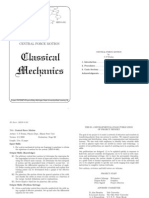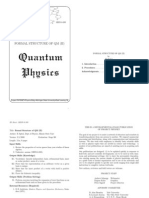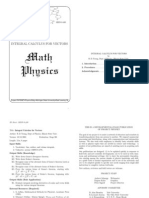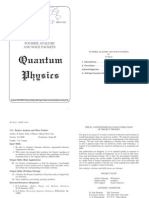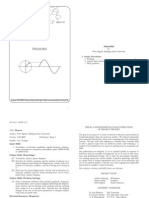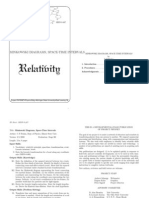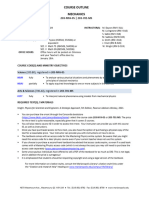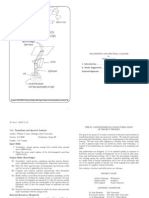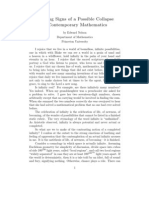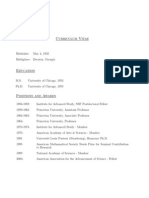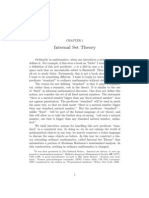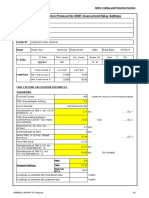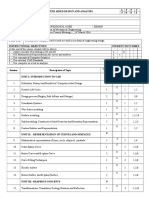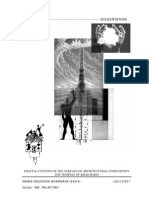Classical Mechanics: Matrices and Transformations
Classical Mechanics: Matrices and Transformations
Uploaded by
Epic WinOriginal Description:
Original Title
Copyright
Available Formats
Share this document
Did you find this document useful?
Is this content inappropriate?
Report this DocumentCopyright:
Available Formats
Classical Mechanics: Matrices and Transformations
Classical Mechanics: Matrices and Transformations
Uploaded by
Epic WinCopyright:
Available Formats
MISN-0-491
MATRICES AND TRANSFORMATIONS
Classical Mechanics
Project PHYSNET Physics Bldg. Michigan State University East Lansing, MI
MATRICES AND TRANSFORMATIONS by C. P. Frahm 1. Introduction . . . . . . . . . . . . . . . . . . . . . . . . . . . . . . . . . . . . . . . . . . . . . . 1 2. Procedures . . . . . . . . . . . . . . . . . . . . . . . . . . . . . . . . . . . . . . . . . . . . . . . . 1 Acknowledgments. . . . . . . . . . . . . . . . . . . . . . . . . . . . . . . . . . . . . . . . . . . .3
ID Sheet: MISN-0-491 THIS IS A DEVELOPMENTAL-STAGE PUBLICATION OF PROJECT PHYSNET The goal of our project is to assist a network of educators and scientists in transferring physics from one person to another. We support manuscript processing and distribution, along with communication and information systems. We also work with employers to identify basic scientic skills as well as physics topics that are needed in science and technology. A number of our publications are aimed at assisting users in acquiring such skills. Our publications are designed: (i) to be updated quickly in response to eld tests and new scientic developments; (ii) to be used in both classroom and professional settings; (iii) to show the prerequisite dependencies existing among the various chunks of physics knowledge and skill, as a guide both to mental organization and to use of the materials; and (iv) to be adapted quickly to specic user needs ranging from single-skill instruction to complete custom textbooks. New authors, reviewers and eld testers are welcome. PROJECT STAFF Andrew Schnepp Eugene Kales Peter Signell Webmaster Graphics Project Director
Title: Matrices and Transformations Author: C. P. Frahm, Physics Dept., Illinois State Univ Version: 2/1/2000 Length: 2 hr; 9 pages Input Skills: 1. Vocabulary: coordinate system, Cartesian coordinate system, reference frame, inertial frame orthogonal coordinate systems, rectangular coordinate system, dipolar cylindrical coordinate system, coordinate transformation, commutative. 2. State the geometrical denition of a vector (MISN-0-2). 3. Express the projection of a vector on a coordinate axis as a magnitude times an appropriate trigonometric function (MISN-0-2). Output Skills (Knowledge): K1. Vocabulary: matrix, unit matrix, diagonal matrix, transpose of a matrix, inverse of a matrix, orthogonal matrix, scalar, vector, tensor. Output Skills (Rule Application): R1. Carry out these operations involving matrices: multiplication, addition, subtraction, multiplication by a scalar. R2. Determine the determinant and inverse of a square matrix. R3. Determine the transpose and inverse of a product of matrices. Output Skills (Problem Solving): S1. Given a position coordinate or an arbitrary vector, perform a coordinate rotation both symbolically (in terms of matrices) and numerically. External Resources (Required): 1. J. Marion, Classical Dynamics, Academic Press (1988). Evaluation: Stage B0
ADVISORY COMMITTEE D. Alan Bromley E. Leonard Jossem A. A. Strassenburg Yale University The Ohio State University S. U. N. Y., Stony Brook
Views expressed in a module are those of the module author(s) and are not necessarily those of other project participants. c 2001, Peter Signell for Project PHYSNET, Physics-Astronomy Bldg., Mich. State Univ., E. Lansing, MI 48824; (517) 355-3784. For our liberal use policies see: http://www.physnet.org/home/modules/license.html.
MISN-0-491
MISN-0-491
MATRICES AND TRANSFORMATIONS by C. P. Frahm 1. Introduction
In most introductory mechanics courses the emphasis is on the application of the laws of mechanics to various mechanical systems. It is tacitly, if not explicitly, assumed that the calculations are made entirely within one reference frame and, in fact, relative to a single coordinate system xed in that frame. Usually no time is devoted to the problem of converting the description of the motion relative to one coordinate system into the appropriate description relative to another coordinate system. However, such conversion problems are important for at least two reasons. First, there is one of practicality - it is quite often advantageous, either for conceptual or calculational purposes, to move back and forth between two or more coordinate systems and/or reference frames. That is, the problem may be simpler in one system than another. Secondly, and more fundamentally, there is a very strong feeling among most practicing physicists that the laws of physics should have the same form in all inertial frames. This means that the laws of physics must be constructed in such a way that when they are transformed from one frame to another, their form does not change. Hence, it should be clear that a study of transformations is an important part of advanced mechanics. Certain kinds of transformations - those relating descriptions of vector quantities in rotated orthogonal coordinate systems - are very conveniently handled in matrix language while other more complicated transformations are best handled in the language of tensors. This unit is concerned with the fundamental ideas associated with matrices and transformations.
In eq. (1.44) of Marion, a vector is dened to be a quantity which relative to an orthogonal coordinate system has three components and these three components behave in a certain way under coordinate rotations, namely: Ai = ij Aj .
j
Tensors are dened in a similar way. An nth rank tensor is a quantity which has 3 components and transforms like a product of n vectors. (Note that vectors are rst rank tensors while scalars are zeroth rank tensors). Thus under rotations a second rank tensor transforms like: Tkl =
ij
ki lj Tij ,
while a third-rank tensor transforms according to: Tklm =
hij
kh li mj Thij .
2. Work problem 1-4 in Marion. Work these exercises: (1) Evaluate the product 1 2 (2) Given 2 A= 1 2 nd: A2 , AB, BA, B 2 . (3) Using A and B of part (2), evaluate (AB)t and B t At separately and compare. (4) Using A and B of part (2), evaluate detA, A1 , detB, B 1 . Check your results by evaluating AA1 and BB 1 . 0 5 1 1 2 2 , B = 1 1 3 1 1 0 4 2 , 1 2 1 2 0 1 4 .
2. Procedures
1. Read Marion, Sections 1.1-1.9. Write down denitions of the quantities listed in Output Skill K1. Your denition of a matrix should include the multiplication rule, i.e., AB = C
j
Aij Bjk = Cik .
MISN-0-491 (5) Using A and B of part (2) and the preceding results, evaluate: 3 A + BA1 B . 5 (6) Given: 1 0 3 1 2 6 5 3 2 0 , Q= 3 1 4 1 , 2 3
P =
evaluate P Q and QP . If another column of numbers were added to Q so that it would have three columns and four rows, would P Q still be meaningful? How about QP ? 3. Work problems 1-3 and 1-6 in Marion. If a certain point has coordinates (x, y, z) = (2, 1, 3) in the original coordinate system of problem 1-1 of Marion, what are the coordinates of this same physical point in the rotated coordinated system? The momentum of a particle as described in the original coordinate system of problem 1-3 of Marion is given by p = (2 5 + 3 ) gm cm/sec , 1 2 3 where the hats denote unit vectors. What is the momentum of this same particle as described in the rotated coordinate system? Are the physically important quantities, magnitude and direction, altered by the transformation?
Acknowledgments
The author would like to thank Illinois State University for support in the construction of this lesson. Preparation of this module was supported in part by the National Science Foundation, Division of Science Education Development and Research, through Grant #SED 74-20088 to Michigan State University.
You might also like
- Clark Robinson - Dynamical Systems - Stability, Symbolic Dynamics, and Chaos 2nd Edition (Studies in Advanced Mathematics) - CRC Press (1998)Document522 pagesClark Robinson - Dynamical Systems - Stability, Symbolic Dynamics, and Chaos 2nd Edition (Studies in Advanced Mathematics) - CRC Press (1998)laura.embusNo ratings yet
- Overhead Line DesignDocument37 pagesOverhead Line DesignPramod B.Wankhade100% (4)
- Classical Mechanics: Vector AnalysisDocument4 pagesClassical Mechanics: Vector AnalysisEpic WinNo ratings yet
- Classical Mechanics: Central Force MotionDocument6 pagesClassical Mechanics: Central Force MotionEpic WinNo ratings yet
- Harmonic Perturbations: Project PHYSNET Physics Bldg. Michigan State University East Lansing, MIDocument4 pagesHarmonic Perturbations: Project PHYSNET Physics Bldg. Michigan State University East Lansing, MIEpic WinNo ratings yet
- Formal Structure of QM (Ii) : Project PHYSNET Physics Bldg. Michigan State University East Lansing, MIDocument5 pagesFormal Structure of QM (Ii) : Project PHYSNET Physics Bldg. Michigan State University East Lansing, MIEpic WinNo ratings yet
- Classical Mechanics: Calculus of VariationsDocument4 pagesClassical Mechanics: Calculus of VariationsEpic WinNo ratings yet
- Electricity and Magnetism: Review of Vector AnalysisDocument4 pagesElectricity and Magnetism: Review of Vector AnalysisEpic WinNo ratings yet
- Math Physics: Integral Calculus For VectorsDocument4 pagesMath Physics: Integral Calculus For VectorsEpic WinNo ratings yet
- Math Physics: Conformal MappingDocument4 pagesMath Physics: Conformal MappingEpic WinNo ratings yet
- Fourier Analysis and Wave Packets: Project PHYSNET Physics Bldg. Michigan State University East Lansing, MIDocument4 pagesFourier Analysis and Wave Packets: Project PHYSNET Physics Bldg. Michigan State University East Lansing, MIEpic WinNo ratings yet
- Math Physics: Fourier Integrals: Part 1Document4 pagesMath Physics: Fourier Integrals: Part 1Epic WinNo ratings yet
- As Physics Coursework Quality of Measurement ExamplesDocument8 pagesAs Physics Coursework Quality of Measurement Examplesf0jimub1lef2100% (1)
- Relativity: Relativistic Kinematics and Einsteinian OpticsDocument4 pagesRelativity: Relativistic Kinematics and Einsteinian OpticsEpic WinNo ratings yet
- Classical Mechanics: Driven OscillationsDocument4 pagesClassical Mechanics: Driven OscillationsEpic WinNo ratings yet
- Relativity: Weak-Field Approximation and Gravitational WavesDocument4 pagesRelativity: Weak-Field Approximation and Gravitational WavesEpic WinNo ratings yet
- Classical Mechanics: Rigid Bodies The Inertia TensorDocument4 pagesClassical Mechanics: Rigid Bodies The Inertia TensorEpic WinNo ratings yet
- Mechanical Engineering Dynamics: (Higher)Document53 pagesMechanical Engineering Dynamics: (Higher)Anonymous FGryb4rEgNNo ratings yet
- Multidimensional Data AnalysisDocument24 pagesMultidimensional Data AnalysisNovia WidyaNo ratings yet
- The SCHR Odinger Equation: Project PHYSNET Physics Bldg. Michigan State University East Lansing, MIDocument5 pagesThe SCHR Odinger Equation: Project PHYSNET Physics Bldg. Michigan State University East Lansing, MIEpic WinNo ratings yet
- 8th Grade PBLDocument9 pages8th Grade PBLapi-268936305No ratings yet
- Barron's Physics Practice Plus: 400+ Online Questions and Quick Study ReviewFrom EverandBarron's Physics Practice Plus: 400+ Online Questions and Quick Study ReviewNo ratings yet
- AFEM Ch01Document15 pagesAFEM Ch01Kim NovisNo ratings yet
- Math Physics: Analytic FunctionsDocument5 pagesMath Physics: Analytic FunctionsEpic WinNo ratings yet
- Rectangular Potentials: Project PHYSNET Physics Bldg. Michigan State University East Lansing, MIDocument4 pagesRectangular Potentials: Project PHYSNET Physics Bldg. Michigan State University East Lansing, MIEpic WinNo ratings yet
- Module Physics For EngineersDocument43 pagesModule Physics For EngineersASTRERO John Denver F.No ratings yet
- Research Paper On Quantum MechanicsDocument6 pagesResearch Paper On Quantum Mechanicsvguomivnd100% (1)
- Physics AM 26: SyllabusDocument20 pagesPhysics AM 26: SyllabusBernice JohnsonNo ratings yet
- Math Physics: Vector Algebra: A ReviewDocument6 pagesMath Physics: Vector Algebra: A ReviewEpic WinNo ratings yet
- Phasors: Project PHYSNET Physics Bldg. Michigan State University East Lansing, MIDocument6 pagesPhasors: Project PHYSNET Physics Bldg. Michigan State University East Lansing, MIEpic WinNo ratings yet
- The Gravitational Field: Project PHYSNET Physics Bldg. Michigan State University East Lansing, MIDocument6 pagesThe Gravitational Field: Project PHYSNET Physics Bldg. Michigan State University East Lansing, MIEpic WinNo ratings yet
- Computer Science Project WorkDocument21 pagesComputer Science Project Workเชี่ย คุณNo ratings yet
- Engineering Mechanics Course Out ComesDocument5 pagesEngineering Mechanics Course Out ComesallakagopichandNo ratings yet
- TextbookDocument100 pagesTextbookgreys0undNo ratings yet
- Time-Dependent Perturbations I: Project PHYSNET Physics Bldg. Michigan State University East Lansing, MIDocument5 pagesTime-Dependent Perturbations I: Project PHYSNET Physics Bldg. Michigan State University East Lansing, MIEpic WinNo ratings yet
- Lecture01 Spring05 PDFDocument25 pagesLecture01 Spring05 PDFtripratiwi4586No ratings yet
- 3.b.tech ME 3rd Sem Syllabus UEMJ-1Document18 pages3.b.tech ME 3rd Sem Syllabus UEMJ-1Saswat SharmaNo ratings yet
- A Case Study On Projectile MotionDocument6 pagesA Case Study On Projectile MotionEditor IJTSRDNo ratings yet
- Electricity and Magnetism: Magnetostatics Induction, Vector PotentialDocument6 pagesElectricity and Magnetism: Magnetostatics Induction, Vector PotentialEpic WinNo ratings yet
- Physics A LevelDocument17 pagesPhysics A LevelvickycamilleriNo ratings yet
- The Dirac Delta Function: Project PHYSNET Physics Bldg. Michigan State University East Lansing, MIDocument4 pagesThe Dirac Delta Function: Project PHYSNET Physics Bldg. Michigan State University East Lansing, MIEpic Win100% (1)
- Relativity: Einstein'S Field EquationsDocument4 pagesRelativity: Einstein'S Field EquationsEpic WinNo ratings yet
- Projects 2015Document45 pagesProjects 2015Steven ArcadoNo ratings yet
- Dissertation Mit BachelorDocument6 pagesDissertation Mit BachelorWhereToBuyResumePaperUK100% (1)
- Huang. A Concise Introduction To Mechanics of Rigid BodiesDocument197 pagesHuang. A Concise Introduction To Mechanics of Rigid BodiesCandis Sharp100% (1)
- Prelim (2) - Physics-1 ModuleDocument52 pagesPrelim (2) - Physics-1 ModuleHerrera, Mark NathanielNo ratings yet
- Phy 107Document2 pagesPhy 107fahadNo ratings yet
- 1706 06446 PDFDocument36 pages1706 06446 PDFعمرو دراغمةNo ratings yet
- " Physics" With Calculus Concurrent Minimal Requirement: Math 140 "First Semester Calculus" Text: Halliday Resnick Walker, Fundamentals of Physics, Extended, 9th EditionDocument16 pages" Physics" With Calculus Concurrent Minimal Requirement: Math 140 "First Semester Calculus" Text: Halliday Resnick Walker, Fundamentals of Physics, Extended, 9th Editionjchwa04No ratings yet
- Module - 1Document25 pagesModule - 1Cedric EnticoNo ratings yet
- Relativistic Energy and Momentum: DerivationDocument4 pagesRelativistic Energy and Momentum: DerivationEpic WinNo ratings yet
- Relativity: Minkowski Diagrams, Space-Time IntervalsDocument4 pagesRelativity: Minkowski Diagrams, Space-Time IntervalsEpic WinNo ratings yet
- Unit 3 Physics Motion v5Document43 pagesUnit 3 Physics Motion v5123HopperNo ratings yet
- 4th Grade Ngss StandardsDocument8 pages4th Grade Ngss Standardsapi-261541929No ratings yet
- W24 PHY-NYA-701 Classical Mechanics OUTLINEDocument9 pagesW24 PHY-NYA-701 Classical Mechanics OUTLINEs0ph13.sushiNo ratings yet
- Physics Honor's SyllabusDocument39 pagesPhysics Honor's Syllabusmoives pointNo ratings yet
- Book-16 FMDocument10 pagesBook-16 FMYsharath ChandramouliNo ratings yet
- Transitions and Spectral Analysis: Two Slit Images (Two Lines)Document4 pagesTransitions and Spectral Analysis: Two Slit Images (Two Lines)Epic WinNo ratings yet
- Warning Signs of A Possible Collapse of Contemporary MathematicsDocument12 pagesWarning Signs of A Possible Collapse of Contemporary MathematicsEpic WinNo ratings yet
- Syntax and Semantics: WWW - Math.princeton - Edu Nelson Papers - HTMLDocument7 pagesSyntax and Semantics: WWW - Math.princeton - Edu Nelson Papers - HTMLEpic WinNo ratings yet
- InequalitiesDocument192 pagesInequalitiesEpic Win100% (2)
- The Mystery of Stochastic MechanicsDocument18 pagesThe Mystery of Stochastic MechanicsEpic WinNo ratings yet
- Mathematics and The Mind: Nelson/papers - HTMLDocument6 pagesMathematics and The Mind: Nelson/papers - HTMLEpic WinNo ratings yet
- RomeDocument7 pagesRomeEpic WinNo ratings yet
- Understanding Intuitionism: WWW - Math.princeton - Edu Nelson Papers - HTMLDocument20 pagesUnderstanding Intuitionism: WWW - Math.princeton - Edu Nelson Papers - HTMLEpic WinNo ratings yet
- Nelson BibDocument5 pagesNelson BibEpic WinNo ratings yet
- IstDocument34 pagesIstEpic WinNo ratings yet
- Edward NelsonDocument1 pageEdward NelsonEpic WinNo ratings yet
- Hilbert's Mistake: Edward Nelson Department of Mathematics Princeton UniversityDocument27 pagesHilbert's Mistake: Edward Nelson Department of Mathematics Princeton UniversityEpic WinNo ratings yet
- HopeDocument4 pagesHopeEpic WinNo ratings yet
- Internal Set TheoryDocument26 pagesInternal Set TheoryEpic WinNo ratings yet
- J. P. MayDocument17 pagesJ. P. MayEpic WinNo ratings yet
- J-Spectra For A Quotient Group J of G. That Context Gives An Interesting SituationDocument9 pagesJ-Spectra For A Quotient Group J of G. That Context Gives An Interesting SituationEpic WinNo ratings yet
- Probability Theory: 1 Heuristic IntroductionDocument17 pagesProbability Theory: 1 Heuristic IntroductionEpic WinNo ratings yet
- Setting Calculation Protocol For IDMT Over Current RelayDocument2 pagesSetting Calculation Protocol For IDMT Over Current Relayrefaate100% (3)
- October 2021 Int A Level FinalDocument16 pagesOctober 2021 Int A Level Finalabrar mahir SahilNo ratings yet
- Cad SyllabusDocument5 pagesCad SyllabusSachi DhanandamNo ratings yet
- Cambridge International Advanced Subsidiary and Advanced LevelDocument12 pagesCambridge International Advanced Subsidiary and Advanced LevelPeter TaremwaNo ratings yet
- Kompozit Sınav SorularıDocument13 pagesKompozit Sınav SorularıBilim KapsülüNo ratings yet
- Waves and Rays in Elastic ContinuaDocument20 pagesWaves and Rays in Elastic ContinuaLiana RitterNo ratings yet
- Estimate Vibration Risk For Relief and Process PipingDocument28 pagesEstimate Vibration Risk For Relief and Process PipingTeknologi TermutakhirNo ratings yet
- Elecrtical Thrust Vector Control Details - Tillo VanthuyneDocument7 pagesElecrtical Thrust Vector Control Details - Tillo VanthuyneCosmisteNo ratings yet
- Solutions 05Document3 pagesSolutions 05Jp PandeyNo ratings yet
- Chap 5 CamsDocument47 pagesChap 5 CamsAlysNo ratings yet
- Dokumen - Tips - Vertical Raw Mill Heat Balance SolutionDocument3 pagesDokumen - Tips - Vertical Raw Mill Heat Balance SolutionRamadhani AhdiyakaNo ratings yet
- LM7805Document9 pagesLM7805derf86No ratings yet
- 04 Dse Math 2014 Paper 1 Solution OnlyDocument7 pages04 Dse Math 2014 Paper 1 Solution OnlyHerrscher of GamezNo ratings yet
- CH5 Drilling FluidsDocument48 pagesCH5 Drilling FluidsThev Ruban100% (1)
- As Maths Unit 2 Question Paper Jan20Document24 pagesAs Maths Unit 2 Question Paper Jan20Vedant DasNo ratings yet
- Electrical & Electronics Measurement Lab ManualDocument64 pagesElectrical & Electronics Measurement Lab ManualHari Krish100% (1)
- DM Plant OperationDocument23 pagesDM Plant OperationKanaga Sundaram80% (5)
- Dissertation - Fractal Content Khajuraho TemplesDocument50 pagesDissertation - Fractal Content Khajuraho TemplesDRB_Scribd100% (4)
- DecimalDocument15 pagesDecimalLIND'71No ratings yet
- 4 - Design of Bitumen MixesDocument25 pages4 - Design of Bitumen MixesKwasi Agyeman-Boakye100% (2)
- AttachmentDocument285 pagesAttachmentAman jaiNo ratings yet
- Wallach Zoomscope User ManualDocument24 pagesWallach Zoomscope User ManualEnmanuelSuárezNo ratings yet
- A3.32-CIRED - Final Report-Compressed PDFDocument215 pagesA3.32-CIRED - Final Report-Compressed PDFRobbyRobbyNo ratings yet
- Types of Beamforming: Adaptive AntennasDocument33 pagesTypes of Beamforming: Adaptive AntennasHarryNo ratings yet
- HarconenDocument21 pagesHarconenUnu AcoloNo ratings yet
- STAAD Rayleigh FrequencyDocument3 pagesSTAAD Rayleigh FrequencyKasim PolatNo ratings yet
- FMDS0289 Pipe Friction LossDocument64 pagesFMDS0289 Pipe Friction Lossdaniela hritucNo ratings yet
- Resistance To Unsnapping of Snap Fasteners: Standard Test Method ForDocument4 pagesResistance To Unsnapping of Snap Fasteners: Standard Test Method Forajay nigamNo ratings yet
- EEE 439 Communication Systems IIDocument35 pagesEEE 439 Communication Systems IIAurongo NasirNo ratings yet




